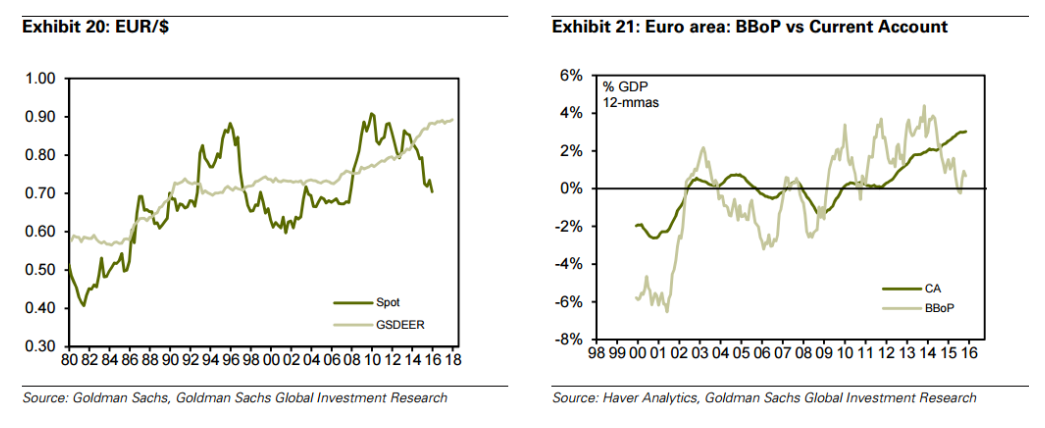Goldman Sachs on why they continue to see euro declines

From Goldman Sachs:
Euro: FX Forecasts: We maintain our EUR/USD forecasts of 1.04, 1.00 and 0.95 in 3, 6 and 12 months, which we reverted to on January 21. This implies EUR/¥ at 127, 125 and 124 in 3, 6 and 12 months.
Motivation for Our FX View: We continue to believe that EUR/USD and EUR/GBP will move substantially lower on diverging growth and monetary policy outlooks. The EUR has already weakened significantly over the last 18 months, but we think this trend has a long way to run. In particular, we see a couple of longer-term fundamental forces at work. First, the flow picture should turn increasingly EUR-negative as Euro area residents send funds abroad and reserve managers allocate away from the EUR. Second, we think there is a structural element to disinflation in the periphery as it continues to improve competitiveness compared with the core of the Euro area. As a result, our view is that inflation will be slower to pick up than during a normal cycle, in line with projections from our European team, which show HICP inflation reverting to target only slowly. This will keep ECB policy accommodative, maintaining downward pressure on the EUR.
Monetary Policy and FX Framework: The ECB is a strict inflation targeter and has recently made more explicit its inflation-based forward guidance. The Euro floats freely. FX policy responsibility is shared between the ECB and Eurogroup.
Growth/Inflation Outlook: Reflecting lower oil prices and more aggressive monetary policy, we expect resilient growth in 2015. We forecast that the Euro area will expand by 1.7%yoy in 2016, a modest improvement over 1.5% growth in 2015, but substantially above the 0.9% recorded in 2014. Nevertheless, we expect core inflation to rise only slowly. Our forecast for core inflation of 1.0% in 2016 is well below the ECB staff's 1.3% projection. We expect core inflation to rise slowly from just below 1.0% to 1.7% by end-2018.
Monetary Policy Forecast: In December, the ECB cut its deposit rate by 10bp and extended its QE programme until March 2017. The downside risks to its forecast have since increased, and in January the ECB made it clear that it would review and possibly reconsider its monetary policy stance as soon as March. We expect the ECB to extend its QE programme at the current pace through September 2017 and cut its deposit rate by another 10bp. Our inflation projections, which show a more moderate increase than the ECB staff forecast, suggest that a decision to reduce policy accommodation remains a long way off.
Fiscal Policy Outlook: Fiscal policy has been highly contractionary in recent years, but turned more neutral in 2014. We expect it to remain close to neutral over the next several years.
Balance of Payments Situation: The Euro area is currently recording a current account surplus of about 3% of GDP on a trend basis, leading to a slightly positive BBoP. Portfolio inflows have slowed, and there are signs that Euro area investors have started to buy more foreign assets. We expect that to continue. Things to Watch: Developments in the European sovereign situation, in particular the implementation of fiscal reforms and long-term fiscal and political reforms, remain the key risk in focus.
For bank trade ideas, check out eFX Plus.



